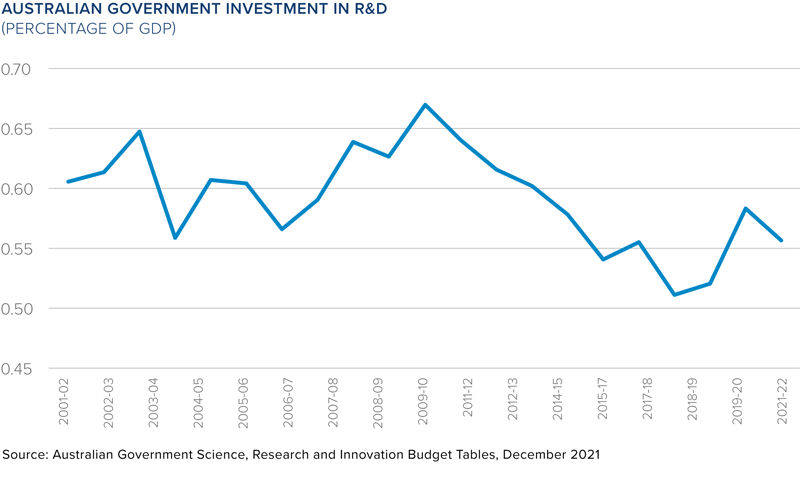Australian science needs long-term investment
- An investment strategy for science and research is essential to secure Australia’s scientific capacity so fundamental to our future in an uncertain world, and to find solutions to our nation’s challenges.
- A strong science sector relies on long-term, consistent and coherent government funding – the ‘patient capital’ – to support discovery and innovation.
Australia needs sustained investment in science
Science is fundamental to our capacity to address the major challenges faced by our nation. It has a pivotal role in developing the ideas, systems and processes needed to provide Australians with a secure, prosperous and fair society.
Our pandemic response, national security, capacity to mitigate and adapt to the destructive forces of climate change, and our recovery from extreme events such as floods and bushfires, depend on science. It is science that supplies the aggregate knowledge developed by many years of investment of ‘patient capital’ central to discovery: the rapid development of mRNA vaccines was founded on work that began around 40 years ago, not in 2020.
Investing in science capability protects Australia’s national interests. There are uniquely Australian problems that only we will have the motivation to solve. Challenges such as the impacts of climate change on the Great Barrier Reef, securing our agricultural sector against changing climate and weather and protecting our unique biodiversity will not be addressed by researchers in other countries.
A long-term investment strategy for science
A 10-year, long-term investment strategy for science is essential to secure the scientific knowledge and discovery needed to underpin future technologies and commercial opportunities. It should include growth, focus and coherence.
Industry Innovation and Science Australia reports that in 2019–20 the Australian Government’s innovation, science and research investment was split across 202 programs and 13 portfolios.
This fragmentation is indefensible, made worse because few programs, if any, fund the actual cost of research, so researchers have to secure multiple grants for the work that a single grant would cover in a fit-for-purpose system.
An excellent long-term investment strategy would feature:
- adequate funding, with a proportion directed to building Australia’s comparative and competitive advantage and balanced across fundamental research, applied research and experimental development
- a secure workforce pipeline, with PhD students remunerated at fair and reasonable levels, together with sustainable career options for early- and mid-career researchers
- continuity of investment for research infrastructure, maintained and relevant to contemporary research needs
- an international science engagement and diplomacy strategy to enhance international research collaboration
- an ambition to grow the quantum, the excellence and the impact of Australian science
Current state of investment in Australian R&D
There has been a decline in support for fundamental research – the building block from which applications and innovations are derived. The drift to short-term project funding, reliance on unstable income streams such as revenue from international student fees, unnecessarily lengthy and burdensome application processes, and a demoralising decline in success rates, are all signs of a sector not fit-for-purpose.
Australia’s investment in research and development (R&D) as a proportion of gross domestic product (GDP) has fallen over the past decade. In 2021 the Australian Government’s investment was 0.56% of GDP, behind nations such as Germany, Japan, the United Kingdom, France and the United States. In 2019, R&D investment (Gross Domestic Expenditure on R&D) as a percentage of GDP was 1.79%, way below the OECD average of 2.5%.
Recent trends in government funding have focused on work with anticipated practical and commercial outcomes, but reducing support for fundamental research is like taking books from the library and never replacing them. Sooner or later, there are no books.
The pandemic dilemma – stronger or weaker?
The pandemic has cost Australian research. Our university sector’s scientists, researchers and technicians comprise 45% of our national research workforce. From 2020 to 2021, the higher education sector reported a loss of 9,000 (7% decrease) full-time equivalent staff.
Australia’s science sector will emerge from the pandemic weaker than it went in unless the value of investment in science and the research base is accepted and supported in Australia, as it is in our ambitious international comparators: strategic, focused, energised.
Questions to stimulate discussion
- Where are the opportunities for change to improve Australia’s research funding system?
- What key features should a long-term investment strategy for science include?
- How could the research community be involved in reviews of long-term research priorities?
This topic's links to the Sustainable Development Goals:
This document has been produced by the Australian Academy of Science to stimulate debate. Read the official position statements of the Academy.
This feature article from the Australian Academy of Science is part of the ‘Science for Australians’ series where experts are asked to shed light on how science benefits all Australians and how it can be used to inform policy.







